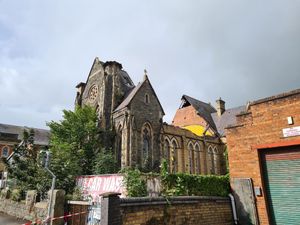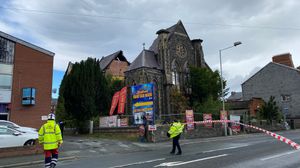Warning had been made about state of collapsed Newtown chapel
Newtown town council had warned that a derelict chapel in the town could collapse.

The town's Mayor, Councillor Richard Williams, said concerns came true this week when the mid section of the roof of Bethel Chapel in New Road caved in.
Councillor Williams said: "I am saddened and disappointed by the collapse. Though it is privately owned, Bethel Chapel has been a historic landmark feature of our town for over 124 years.
"Through our Place Plan work, the Town Council has been pressing Powys County Council to take action from the point of view of conservation of historic building and street scene, and for public safety.
"The Town Council recently discussed Powys County Council’s response to our concerns at this month’s meeting of the Council’s Economy and Environment Committee, where Councillors expressed further concerns at the potential to collapse and cause damage to surrounding properties. Unfortunately, this collapse has come true.
"I have no doubt that the Town Council will continue its efforts to persuade Powys County Council to take the appropriate action."
Newtown Town Council contacted the owner in 2019, along with owners of other empty properties, asking what plans there were for the building. But it never received a reply.
Powys County Council said following the collapse that it was seeking talks with the owner over the future of the property.
Conservation Architect Doug Hughes, said the architectural heritage of communities throughout Mid Wales and Shropshire was slowly being eroded as more older buildings fall into decay.
Mr Hughes said the collapse of Bethel Chapel’s roof was a stark reminder of the state of many abandoned older buildings throughout the region.
“We’re facing many historic and older buildings in the heart of our communities falling into a dangerous state and decaying. Bethel Chapel brings the issue to the fore where we have a well-known structure along a key road slowly falling apart in front of our eyes, to the extent that the main roof has now totally collapsed, said Mr Hughes of Mid Wales-based planning and building design practice, Hughes Architects.
"There are similar buildings around Mid Wales in similar conditions, either because they have been abandoned or neglected. In some cases, the owners simply don’t have the money to invest in them.
“Most of these buildings are an important part of our heritage, whether former churches, stone barns, houses or even industrial buildings. Just because they are no longer being used for their original purpose does not mean they cannot be converted for alternative uses such as residential or commercial accommodation.”

Mr Hughes said he believed a formal register should be set up of any historic or architecturally important structures that might be in danger of neglect or collapse.
“Planning regulations are already there to protect certain buildings. We have a Listed building system in place where properties of architectural, heritage or social importance are registered through CADW or Historic England. Only certain works, renovations or remodelling can take place on such buildings depending on whether they’re Grade I or Grade II* or Grade II Listed.
“Unfortunately, some buildings like Bethel Chapel fall between the gaps and then into disrepair.”
He said former churches and chapels could be easily converted or refurbished for domestic or commercial use. Conservation Architects have the necessary knowledge and skills to work on such projects with the local authorities, CADW and Historic England.
He said: “It’s not just town centre structures where we’re seeing buildings decay. There are many buildings, such as barns and former homes in the countryside that are disappearing. These too are important in our architectural history, landscape, and townscapes.
“We need to act fast on many of these buildings to save them, by bringing them back into use for whatever viable purpose we can.”



